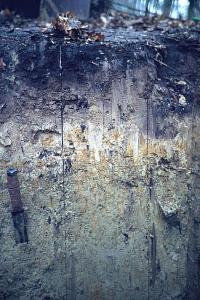Reference soil Netherlands 18: Planosol
Planosols occur in level landscapes throughout the world often associated with broad river valleys.
Characteristics
Soils having an eluvial horizon, the lower boundary of which is marked. within 100 cm from the soil surface, by an abrupt textural change associated with stagnic properties above that boundary. The feature of albeluvic tonguing, however, is lacking.
Reference soil NL018: Planosols
A very dark brown to brown surface horizon and a light yellowish brown eluvial horizon, both with a slightly gravelly loamy sand texture, overlying abruptly a pale olive to light olive gray illuvial horizon with slightly gravelly sandy clay loam to sandy loam texture. Gley mottling appear in the lower part of eluvial horizon, extending down to 325 cm. Groundwater table fluctuates normally from 10 cm in winter and spring to over 100 cm in summer and autumn. Below 145 cm discrete calcareous nodules occur.The parent material is Saalean boulder clay overlying heavy liassic clay deposits. (additional climatic data: xa - insolation (hrs))
